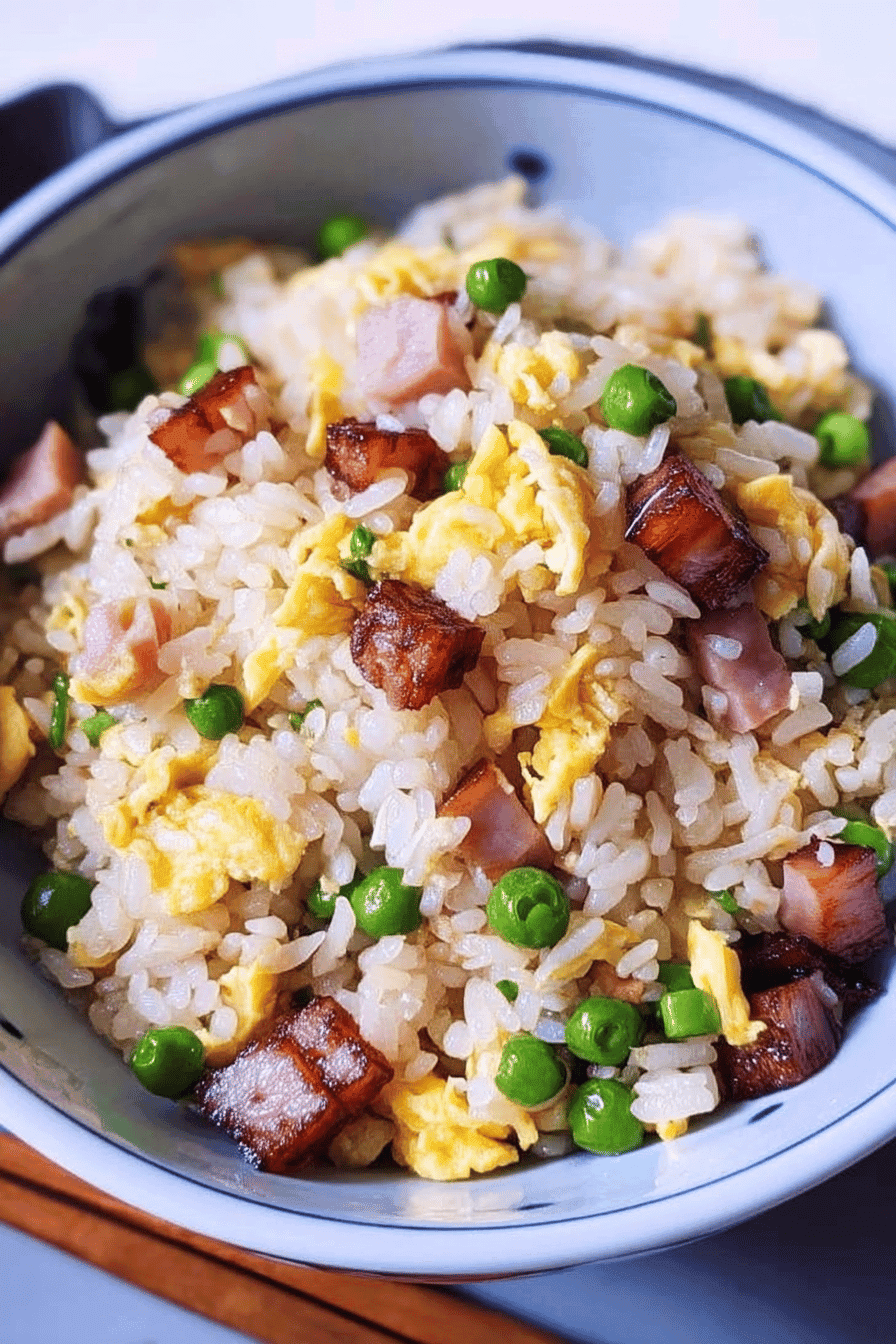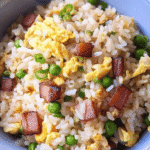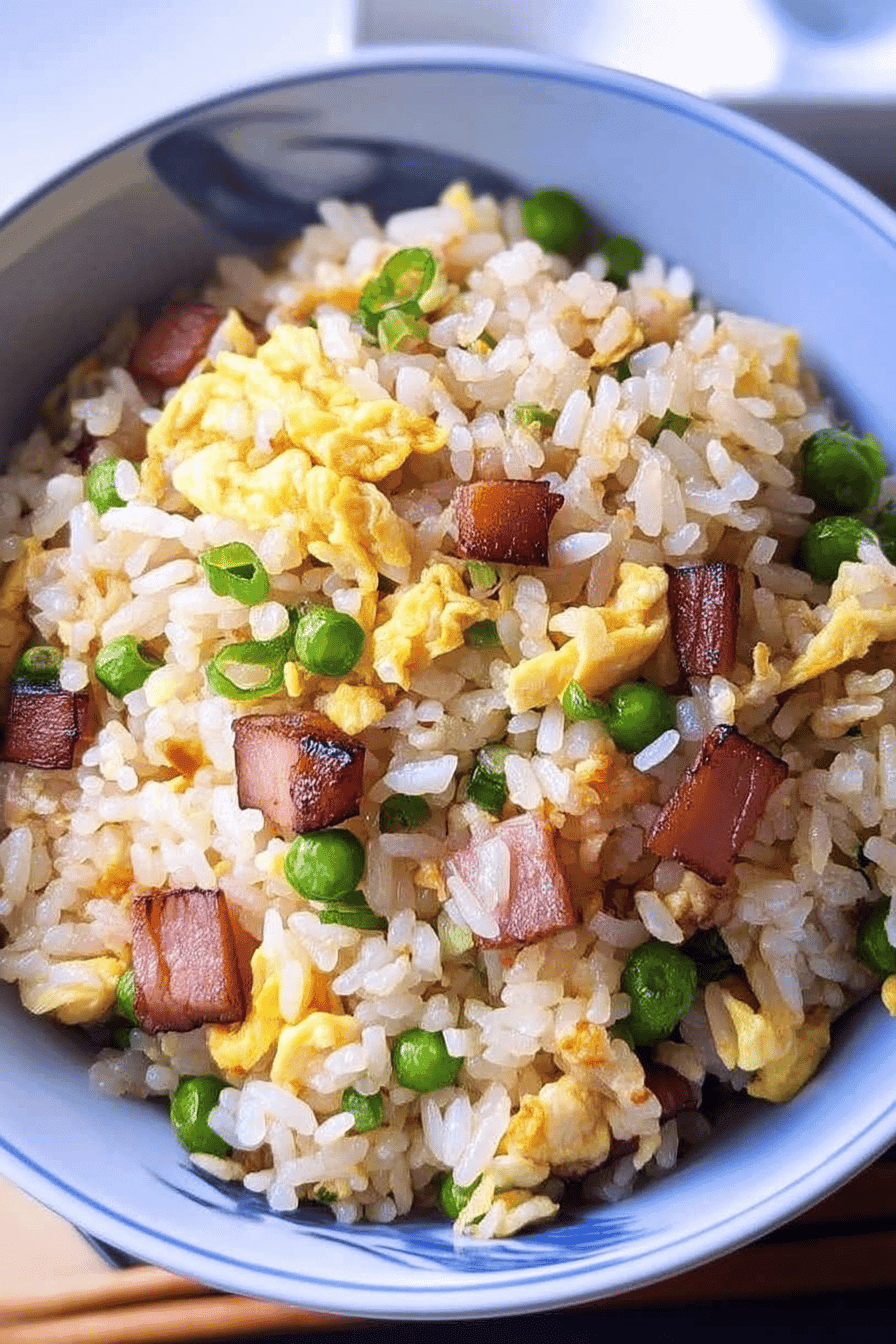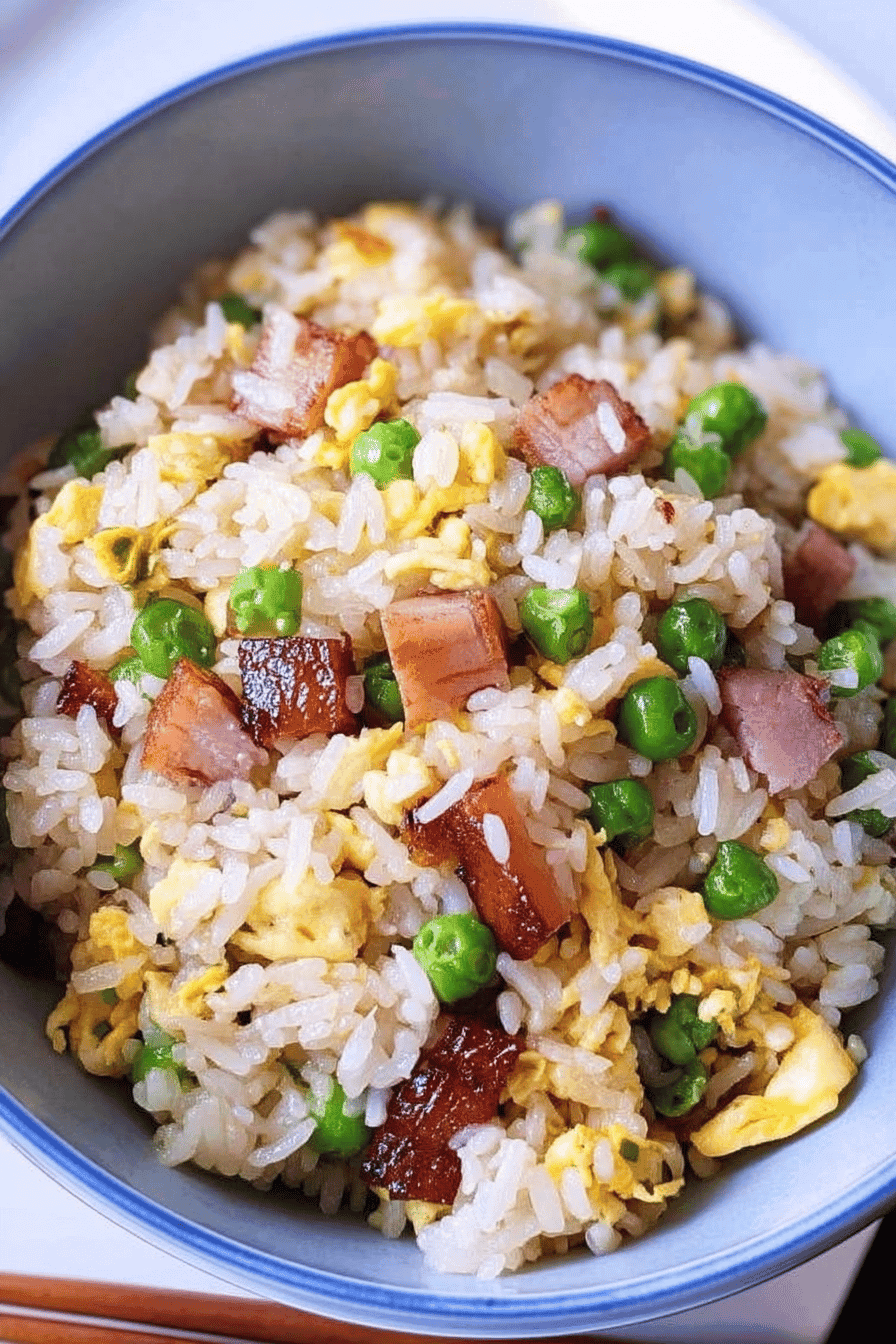Benefits and Advantages of taiwanese fried rice
Taiwanese fried rice is a flavorful and efficient meal choice, blending convenience with nutritional balance. Its quick preparation makes it ideal for those with busy schedules or novice cooks, requiring minimal ingredients and less than 20 minutes of active cooking. The dish combines protein-rich eggs, fresh vegetables, and wholesome jasmine rice, delivering essential nutrients like fiber, vitamins, and minerals in every bite. With a unique savory profile enhanced by careful seasoning, Taiwanese fried rice maintains authentic taste while being easily customizable for various dietary requirements. The method preserves the rice’s texture and moisture, avoiding greasiness or heaviness, which often plague fried rice dishes. Its versatility makes it suitable for diverse palates, allowing for the inclusion or exclusion of optional proteins such as bacon or tofu, aligning with health goals or preferences. Overall, the balance of ease, taste, and wholesome ingredients firmly establishes Taiwanese fried rice as a practical and delightful addition to home cooking repertoires.
Jump To
- 1. Benefits and Advantages of taiwanese fried rice
- 2. Essential Ingredients for taiwanese fried rice
- 3. Dietary Substitutions to Customize Your taiwanese fried rice
- 4. How to Prepare the Perfect taiwanese fried rice: Step-by-Step Guide
- 5. Advanced Tips and Variations
- 6. How to Store taiwanese fried rice: Best Practices
- 7. Nutritional Value of taiwanese fried rice
- 8. FAQs: Frequently Asked Questions About taiwanese fried rice
- 9. taiwanese fried rice
Essential Ingredients for taiwanese fried rice
- 4 cups cooked white jasmine rice, preferably cooled overnight
- 4 eggs, beaten, with a dash of soy sauce and 1 teaspoon sesame oil
- ½ yellow onion, diced
- 1 bunch of green onions, chopped and separated into white and green parts
- ½ cup frozen peas, defrosted
- ½ cup finely chopped or grated carrots
- 1 cup cooked protein (optional): bacon, ham, Chinese sausage, or extra-firm tofu
- 2-3 tablespoons neutral or light-flavored oil (e.g., grapeseed oil) for cooking
- 1 to 2 teaspoons white pepper (adjust to taste)
- Salt to taste
- 1 to 1.5 tablespoons sugar (optional, to balance umami)
- 1.5 tablespoons chicken or mushroom powder (optional, for umami depth without MSG)
- Optional seasonings: garlic, ginger
- Splash of rice or sherry wine (about 2 tablespoons, optional, for flavor enhancement)
Dietary Substitutions to Customize Your taiwanese fried rice
Taiwanese fried rice offers great flexibility, allowing alteration of ingredients to suit dietary needs or preferences while preserving its signature flavors.
- Vegan Options: Replace eggs with tofu scramble or chickpea flour batter. Use plant-based proteins like tofu or tempeh as an optional protein source.
- Gluten-Free Choices: Substitute soy sauce with tamari or coconut aminos to avoid gluten.
- Low-Calorie Versions: Use minimal cooking oil and increase vegetables such as zucchini, bell peppers, or mushrooms to add volume without extra calories.
- Allergen-Friendly: Swap sesame oil for avocado or olive oil; replace garlic with garlic-infused oil for those sensitive to alliums.
- Protein Variations: Incorporate cooked shrimp, chicken, or pork instead of or in addition to traditional options like bacon or sausage.
These substitutions maintain the balanced texture and flavorful profile characteristic of Taiwanese fried rice, making it welcoming for diverse dietary preferences.
How to Prepare the Perfect taiwanese fried rice: Step-by-Step Guide
- Prepare Ingredients: Cook and refrigerate jasmine rice overnight for optimal texture. Dice onions, chop green onions separating white and green parts, and prepare beaten eggs seasoned with soy sauce and sesame oil. Defrost peas and prepare carrots finely chopped or grated. Optionally cook any protein and chop accordingly.
- Cook Eggs: Heat about 1 tablespoon of oil in a wok or large pan over high heat. Add the beaten eggs and scramble until about 70% done. Remove and set aside.
- Sauté Aromatics and Vegetables: Add another tablespoon of oil, then sauté diced yellow onion and white parts of green onions until fragrant. Add optional proteins, followed by peas and carrots, stirring thoroughly.
- Add Wine: Drizzle a splash (about 2 tablespoons) of rice or sherry wine along the pan edge and allow it to evaporate to deepen flavor (optional).
- Stir-Fry Rice: Add more oil if needed, then toss in the rice, breaking up clumps carefully. Stir-fry quickly to coat grains evenly and keep them separate.
- Combine Eggs and Season: Return scrambled eggs to the wok, mixing thoroughly. Season with salt, white pepper (1 to 2 teaspoons), and sesame oil (1 teaspoon). Soy sauce can be added sparingly to avoid overpowering delicate flavors.
- Enhance Umami: Optionally, add sugar and chicken or mushroom powder following a rough ratio of 1:1:0.5 for salt, sugar, and umami powder to balance flavors.
- Finish: Garnish with the green parts of the chopped green onions. Serve hot for a savory, texturally balanced authentic Taiwanese fried rice experience.
Following these steps allows for a quick, customizable, and delicious dish that respects traditional cooking techniques and flavor combinations.
For detailed tips on fried rice preparation, see Tips for Perfect Fried Rice.
Advanced Tips and Variations
To achieve the best results when preparing Taiwanese fried rice, consider these helpful tips and creative variations:
- Use Day-Old Rice: For optimal texture, use rice that has been cooked and refrigerated overnight. This prevents clumping and results in fluffy, separate grains.
- Add Protein: Enhance the dish by stir-frying diced chicken, shrimp, or tempeh along with the vegetables for added flavor and nutrition.
- Flavor Boosters: A splash of rice wine or sherry wine during cooking adds depth and aroma.
- Vegetable Variations: Incorporate baby corn, bean sprouts, or corn kernels for texture diversity and nutritional variety.
- Lower Sodium Option: Use reduced-sodium soy sauce and adjust salt and seasoning accordingly to suit dietary preferences.
- Sweet and Savory Twist: Add pineapple chunks for a delightful sweet contrast that complements the savory flavors.
- Vegan Version: Marinate tofu in soy sauce and sesame oil before cooking to create rich, flavorful vegan fried rice.
These tips allow you to customize Taiwanese fried rice to your taste preferences while retaining the authentic flavor and texture.
How to Store taiwanese fried rice: Best Practices
Proper storage of Taiwanese fried rice helps maintain its taste, texture, and safety:
- Refrigerate Promptly: Place leftover fried rice in an airtight container within two hours of cooking to prevent bacterial growth.
- Storage Duration: Consume refrigerated fried rice within 3 to 4 days for best quality.
- Freezing: For longer storage, freeze fried rice in a freezer-safe container or heavy-duty freezer bag, removing excess air. It can be stored up to 2 months without significant quality loss.
- Reheating: Reheat thoroughly to at least 165°F (74°C). Using a microwave or stovetop works well, stirring occasionally. Add a small splash of water during reheating to restore moisture.
Following these guidelines ensures your Taiwanese fried rice remains delicious and safe to enjoy later.
Nutritional Value of taiwanese fried rice
| Nutrient | Amount per Serving | Health Benefit |
|---|---|---|
| Calories | 300-350 kcal | Satisfies energy needs with balanced ingredients |
| Protein | 10-12 g | Supports muscle repair and growth |
| Carbohydrates | Varied, mainly from jasmine rice | Provides sustained energy |
| Fat | 8-10 g | Includes healthy fats from sesame and cooking oils |
| Fiber | Moderate amount | Aids digestion and promotes fullness |
| Vitamins and Minerals | Vitamins A, C, B-complex; Potassium; Selenium | Boosts immune function and metabolism |

FAQs: Frequently Asked Questions About taiwanese fried rice
What type of rice is best for making Taiwanese fried rice?
For Taiwanese fried rice, use white rice that has been cooked and thoroughly cooled, ideally refrigerated overnight. Day-old rice works best because the grains are firmer and less sticky, preventing clumps and sogginess during stir-frying. Freshly cooked rice tends to be too moist, which can result in a mushy texture.
How do I keep the rice from sticking and clumping when making Taiwanese fried rice?
To avoid clumping, stir-fry the rice over high heat in a dry, hot wok or large pan, and use just enough oil to lightly coat the grains without making them greasy. Break apart any clumps before cooking and avoid overcrowding the pan, as this causes steaming rather than frying.
Can I add raw meat to Taiwanese fried rice, and if so, when should it be added?
Yes, raw proteins like chicken, pork, or shrimp can be added directly. Cook the meat after sautéing aromatics such as garlic, ginger, or scallion whites, but before adding the rice and vegetables. Cooking meat first allows it to fully cook and seal in flavor while keeping the rice texture intact.
What seasonings and aromatics are commonly used in Taiwanese fried rice?
Typical seasonings include a combination of sesame oil, soy sauce (used sparingly), white pepper, and a touch of sugar to balance flavors. Aromatics like garlic, ginger, and the white parts of scallions contribute distinctive fragrance and depth. Some recipes also include a small amount of cooking wine for extra aroma.
Is a wok necessary for making authentic Taiwanese fried rice?
While a wok is preferred due to its ability to distribute high heat evenly and quickly, a large, flat-bottomed skillet can also produce good results. The key is to maintain high heat and avoid overcrowding to ensure the rice fries rather than steams, preserving its texture and flavor.

taiwanese fried rice
- Total Time: 20 minutes
- Yield: 4 servings 1x
- Diet: Vegetarian
Description
🍚 Taiwanese Fried Rice combines fluffy rice with eggs and fresh veggies for a quick, satisfying meal full of authentic flavors.
🥢 Ready in just 20 minutes, this recipe is perfect for a flavorful weeknight dinner or a tasty lunch option.
Ingredients
4 cups cooked white jasmine rice, preferably cooled overnight
4 eggs, beaten, with a dash of soy sauce and 1 teaspoon sesame oil
½ yellow onion, diced
1 bunch of green onions, chopped and separated into white and green parts
½ cup frozen peas, defrosted
½ cup finely chopped or grated carrots
1 cup cooked protein (optional): bacon, ham, Chinese sausage, or extra-firm tofu
2–3 tablespoons neutral or light-flavored oil (e.g., grapeseed oil) for cooking
1 to 2 teaspoons white pepper (adjust to taste)
Salt to taste
1 to 1.5 tablespoons sugar (optional, to balance umami)
1.5 tablespoons chicken or mushroom powder (optional, for umami depth without MSG)
Optional seasonings: garlic, ginger
Splash of rice or sherry wine (about 2 tablespoons, optional, for flavor enhancement)
Instructions
Prepare Ingredients: Cook and refrigerate jasmine rice overnight for optimal texture. Dice onions, chop green onions separating white and green parts, and prepare beaten eggs seasoned with soy sauce and sesame oil. Defrost peas and prepare carrots finely chopped or grated. Optionally cook any protein and chop accordingly.
Cook Eggs: Heat about 1 tablespoon of oil in a wok or large pan over high heat. Add the beaten eggs and scramble until about 70% done. Remove and set aside.
Sauté Aromatics and Vegetables: Add another tablespoon of oil, then sauté diced yellow onion and white parts of green onions until fragrant. Add optional proteins, followed by peas and carrots, stirring thoroughly.
Add Wine: Drizzle a splash (about 2 tablespoons) of rice or sherry wine along the pan edge and allow it to evaporate to deepen flavor (optional).
Stir-Fry Rice: Add more oil if needed, then toss in the rice, breaking up clumps carefully. Stir-fry quickly to coat grains evenly and keep them separate.
Combine Eggs and Season: Return scrambled eggs to the wok, mixing thoroughly. Season with salt, white pepper (1 to 2 teaspoons), and sesame oil (1 teaspoon). Soy sauce can be added sparingly to avoid overpowering delicate flavors.
Enhance Umami: Optionally, add sugar and chicken or mushroom powder following a rough ratio of 1:1:0.5 for salt, sugar, and umami powder to balance flavors.
Finish: Garnish with the green parts of the chopped green onions. Serve hot for a savory, texturally balanced authentic Taiwanese fried rice experience.
Notes
🔥 Use day-old rice that has been properly cooled to achieve the perfect fried rice texture without clumping.
🍳 Cook the eggs first and set aside to fold in later for fluffy, well-distributed eggs throughout.
🌶️ Maintain a very hot wok or pan and work quickly to avoid steaming the rice and keep it dry and separate.
- Prep Time: 10 minutes
- Cooking Time: 10 minutes
- Cook Time: 10 minutes
- Category: Main Dish
- Method: Stir-Frying
- Cuisine: Taiwanese
Nutrition
- Serving Size: 1 cup
- Calories: 320 kcal
- Sugar: 2 g
- Sodium: 700 mg
- Fat: 8 g
- Saturated Fat: 1 g
- Unsaturated Fat: 6 g
- Trans Fat: 0 g
- Carbohydrates: 50 g
- Fiber: 3 g
- Protein: 8 g
- Cholesterol: 110 mg
Keywords: Taiwanese Fried Rice, Egg Fried Rice, Quick Fried Rice, Vegetable Fried Rice



Just made this and OMG it’s delicious! I added a little sriracha for some extra spice, and it turned out great! 🌶️🥢
★★★★★